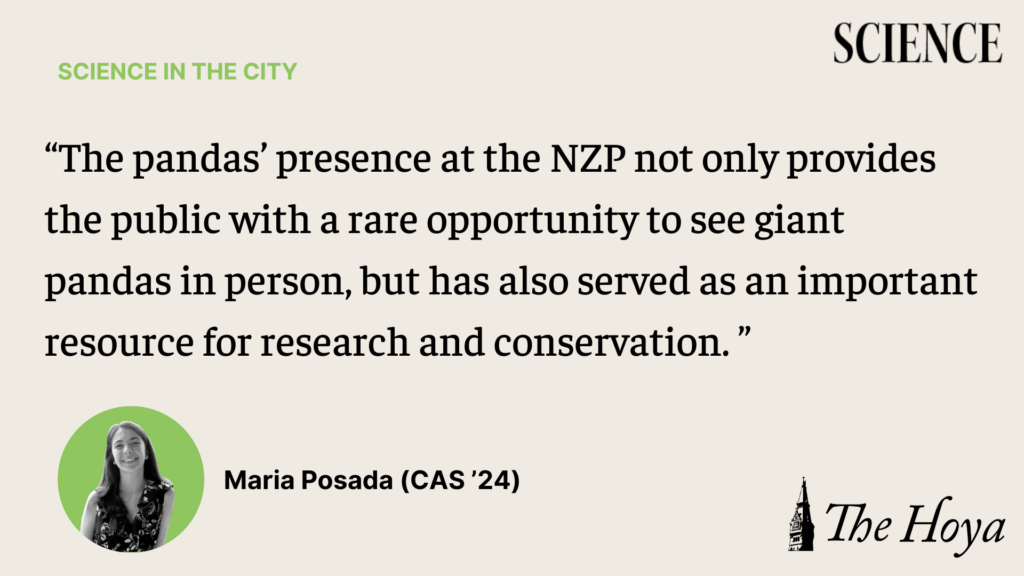Regardless of what your major is, or what career you hope to pursue, engaging with science outside of the classroom has a lot of value. Interacting directly with science can help take abstract concepts and make it clear why these concepts actually matter in our lives.
The Smithsonian National Zoo (NZP), for one, allows us to see animals in person that most people would only be able to see in pictures or textbooks. By directly experiencing these incredible species’ behaviors and learning about efforts to protect them, the conservation of these animals is brought to the forefront of people’s minds, which can motivate people to contribute to these efforts in any way they can.
The Smithsonian National Zoo is a short 35-minute commute away from the Georgetown campus and is a place where we can see conservation science in action. The giant pandas in particular have become one of the most emblematic species at the zoo since their arrival in 1972, attracting millions of visitors from around the world since. However, the pandas’ 50-year stay in Washington, D.C. will soon be over, as they will be returning to China on Dec. 7th.
The current pandas, Mei Xiang and Tian Tian, arrived in D.C. in 2000 and after 23 years here, it is hard to imagine the NZP without them. In Nov. 2020, Mei Xiang and Tian Tian had a baby whose name was voted by the public to be Xiao Qi Ji, or ‘Little Miracle’ in English. Their popularity was made clear at the end of September when visitors attended a 9-day ‘Panda Palooza’ farewell party.
The pandas’ presence at the NZP not only provides the public with a rare opportunity to see giant pandas in person, but has also served as an important resource for research and conservation. Pandas are classified as a vulnerable species by the International Union for Conservation of Nature (IUCN). Only 1864 individuals exist in the wild.
Since the arrival of the first pandas, the NZP has received large amounts of funding to develop science-based conservation solutions by studying the ecology of giant pandas and the species they interact with. For example, scientists look for corridors connecting panda reserve areas to protect vital areas of safe panda habitat and connect them with each other. They also look at how climate change is affecting these species and their habitats.
The Smithsonian National Zoo is just one on a long list of zoos whose pandas are being sent back home. San Diego and Memphis Zoos sent their pandas home in 2019 and 2023 respectively, and if the loan agreement is not extended, pandas at the Atlanta Zoo are also set to return home in 2024, leaving the U.S. without this charismatic species for the first time in 50 years. With all of these zoos sending back their pandas, more and more students across the country are losing their opportunity to see this incredible species in person and learn about their health, reproduction and behavioral strategies.
Since the Tang dynasty in the 7th Century, China has engaged in Panda diplomacy, or the gifting or loaning of pandas to signify strong relations with other countries. Sharing the care of these precious animals has been seen as a sign of mutual trust and partnership for centuries. Many are speculating that the pandas are not simply leaving the U.S. because of the end of a loan agreement, but rather because of the deterioration of China-U.S. relations or even more generally the breakdown of relations of China with most of the West. Supporting this panda diplomacy is vital because large-scale conservation research requires a multinational and cross-collaborative scientific and political effort. Losing pandas at the zoo means students will also be losing an opportunity to engage with the political forces that are often at play when conducting scientific research.
Seeing not only the giant panda but the many other species in person provides a great opportunity to learn about animals by seeing their behavior and adaptations. The adorable pandas lounging around eating bamboo, the gentle elephants playing with their enrichment toys and the powerful roar of lions can help inspire people to action and bring conservation to the forefront of people’s minds.
With only a couple of months left to see the pandas, now is an excellent time to visit the NZP. As a hub for conservation science, the NZP is also a great place to learn what methods are being used to conserve vulnerable species like the giant panda and learn how we can contribute to the work that NZP is doing. As well as visiting, there are also opportunities to get involved and make a difference in these conservation efforts. NZP provides volunteering opportunities to support animal care and educate the public about conservation efforts, and opportunities for visitors to donate to the care of zoo animals, as well as the research that their Conservation Biology Institute is doing.
Students should take advantage of visiting NZP to learn more about the pandas and the Smithsonian’s conservation efforts before the animals return to China. Zoos provide an incredible opportunity for us to see animals from all around the world that we may not otherwise be exposed to, but they also allow us to broaden our view of the world and learn more about global environmental and conservation issues beyond what we see in our backyard.









